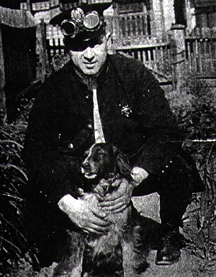On Christmas morning, 1921, Dormont Police Officer Joseph Allen Coghill was shot in the head and killed instantly while he and his partner, Byron Schwartz, arrested two men reported to be burglarizing homes on Dormont Avenue. After placing the men in a patrol vehicle, one of the men drew a concealed weapon and shot the officers. Schwartz recovered from his injuries. The assailants fled.

The search for the killers was so intense that a group of citizens nearly lynched two men caught during a burglary on December 27. Police intervened to prevent any injury. A similar vigilante group chased a group of robbers in Brookline on December 28. Shots were fired in that case. None of the assailants were involved in Coghill’s murder.


John Rush (aliases Ralph Lopez and Manuel Nirelli), who was well known to police, was among those who were arrested in the days after the killing, only to be released due to a lack of evidence.
Continuing investigation allowed police to develop enough evidence to link Rush to Coghill’s killing. He was arrested again on January 23, 1922, on an unrelated charge in the Hill District and was held for Coghill’s murder. He attempted suicide in his jail cell that same day.

Under police questioning, Rush provided inculpatory information. He was also identified as Coghill’s killer by Officer Schwartz as well as Dormont burglary victims and witnesses. He subsequently provided a written confession.

Vincent Paoletti, originally implicated by Rush as his accomplice, was later released after Rush’s statements cleared him. Rush’s accomplice was never definitively identified or apprehended.

Determined to avoid confinement, on March 20, 1922, Rush was found in possession of a gun and was implicated as the leader of an escape plot that included three other inmates facing murder charges, including Walter Troy and Joseph Thomas.
At trial, Rush repudiated his confession, claiming that he gave it in an effort to secure his own execution. He also offered witnesses placing him in the Hill District at the time of the killing. Confronted by eyewitness testimony and that confession, Rush was convicted of first-degree murder on June 24, 1922, and sentenced to death on November 18, 1922.

On appeal, Rush challenged the admissibility of his confession. That challenge was rejected (Commonwealth v. Rush 277 Pa. 419, 1923).
In considering his commutation request, the Pardon Board was persuaded by expert testimony of Rush’s mental instability, including his history of suicide attempts, that his death sentence should be commuted to life imprisonment. Governor Pinchot agreed on October 31, 1923. A serious head injury Rush suffered as a railroad worker a decade earlier was noted as an explanation for his mental instability.
Rush was transferred to Western Penitentiary, where he served until being paroled on June 10, 1946.

His criminal career was not over. John Rush was arrested again in 1947, at age 58, for possession of a firearm and explosives that he planned to use in safe-cracking. He pleaded guilty and was returned to Western Penitentiary, where he died of cancer on June 18, 1960. He was 71 years old.


Interesting articles many I hadn’t seen before. John P Rush was my grandfathers brother so my great uncle. Finding out what he did shed light on why my mother and grandmother referred to him as a black sheep but wouldn’t tell me why.
LikeLike
Hi Bridget, interesting fact for you. John Peter Rush was my great great grandfather. My grandfather’s name was Francis Joseph Rush. So it sounds like we are distant cousins somehow. I would love to hear more information about him if you know any. I was not aware of his history til a few years ago and I have no one to ask about it since my dad, Francis J Rush Jr has been deceased since 1990. So if you have any stories about him or other family history, I’d appreciate it if you could share with me. Thank you, look forward to hearing from you.
LikeLike
Gabriella don’t give up on me
LikeLike